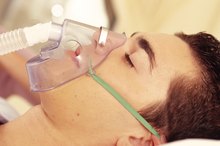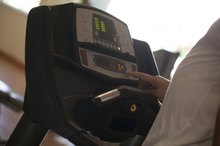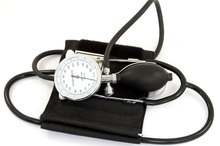How to Set the Pressure on a BiPAP Machine
A bilevel positive airway pressure (BIPAP) machine functions similarly to a continuous positive airway pressure (CPAP) machine except for one main difference 1. The BIPAP allows you to exhale more like you normally would when you are not using the machine 1. When you use a CPAP, you exhale against a continuous airflow. There are pressure settings on your BIPAP machine that are to be set according to your specific needs. Understanding your pressure settings will help you get the maximum benefits out of your BIPAP machine 1.
Adjust your humidifier by either increasing or decreasing the heat setting on your BIPAP machine while it is in standby mode 1. Your machine is in this mode when you first connect it to a power source and before your press the Pressure On or Off button 1. The heat setting begins at 1 and increases to 5. Press the Heat button to change your setting.
How to Adjust Pressure on a Respironics CPAP Machine
Learn More
Navigate to your flex screen by pressing the left or right User button while your machine is in the standby or monitoring mode 1. Change your flex setting by pressing the Heat button to increase your flex time and by pressing the Ramp button to decrease your flex time. The flex setting is designed to allow for the decrease in air pressure when you exhale. You will only see this screen if flex therapy has been prescribed for you.
Change your rise time while your BIPAP machine is in standby or monitoring mode by pressing the left or right User button to scroll to the ramp screen 1. Press the Heat button to increase the number or press the Ramp button to decrease the number. Your rise time begins at 1 for the fastest rise time and ends at 6 for the slowest rise time. The rise setting controls how long it takes your machine to change over from EPAP (breathing out) to IPAP (breathing in). You will only have this screen if you have been prescribed rise time.
How to Adjust the Airflow on a ResMed CPAP S6
Learn More
Adjust your ramp pressure by navigating to the ramp pressure screen while it is in standby or monitoring mode. Press the left or right User button to navigate to the ramp pressure screen. Use the Heat button to increase the ramp pressure and the Ramp button to decrease the ramp pressure. Your ramp pressure is designed to start your machine at a lower setting and then slowly increase to a higher setting. This feature will allow you more comfort when you are in the first stages of sleep. You will not see this screen unless it has been prescribed for you.
Warnings
Your settings have been prescribed by your doctor to meet your specific needs. Do not change any settings until you have permission from your doctor.
Related Articles
References
- The CPAP Shop: Is a Bipap Machine Right for You?
- Panchabhai TS, Mireles cabodevila E, Pioro EP, Wang X, Han X, Aboussouan LS. Pattern of lung function decline in patients with amyotrophic lateral sclerosis: implications for timing of noninvasive ventilation. ERJ Open Res. 2019;5(3).doi.10.1183/23120541.00044-2019
- Hukins C, Murphy M, Edwards T. Dose-response characteristics of noninvasive ventilation in acute respiratory failure. ERJ Open Res. 2020;6(1).doi.10.1183/23120541.00041-2019
- Koga Y, Kaneda K, Fujii N, et al. Comparison of high-flow nasal cannula oxygen therapy and non-invasive ventilation as first-line therapy in respiratory failure: a multicenter retrospective study. Acute Med Surg. 2020;7(1):e461.doi.10.1002/ams2.461
- Donovan LM, Boeder S, Malhotra A, Patel SR. New developments in the use of positive airway pressure for obstructive sleep apnea. J Thorac Dis. 2015;7(8):1323–1342. doi:10.3978/j.issn.2072-1439.2015.07.30
- Ankjærgaard, K.L., Tønnesen, P., Laursen, L.C. et al. Home Non Invasive Ventilation (NIV) treatment for COPD patients with a history of NIV-treated exacerbation; a randomized, controlled, multi-center study. BMC Pulm Med 16, 32 (2016) doi:10.1186/s12890-016-0184-6
- COPD Working Group. Noninvasive positive pressure ventilation for chronic respiratory failure patients with stable chronic obstructive pulmonary disease (COPD): an evidence-based analysis. Ont Health Technol Assess Ser. 2012;12(9):1–51. PMID: 23074437
- Ankaergaard K, Tonnesen P, Laursen L, et al. Home NonInvasive Ventilation (NIV) treatment for COPD patients with a history of NIV-treated exacerbation; a randomized, controlled, multi-center study. BMC Pulmonary Medicine. 2016. 16(1):32.
- Johns Hopkins Medicine. Treatments and Tests: BiPap.
Warnings
- Your settings have been prescribed by your doctor to meet your specific needs.
- Do not change any settings until you have permission from your doctor.
Writer Bio
Based in Oklahoma City, Debbie Tolle has been working in the home-improvement industry since 2001 and writing since 1998. Tolle holds a Master of Science in psychology from Eastern Illinois University and is also a Cisco-certified network associate (CCNA) and a Microsoft-certified systems engineer (MCSE).







